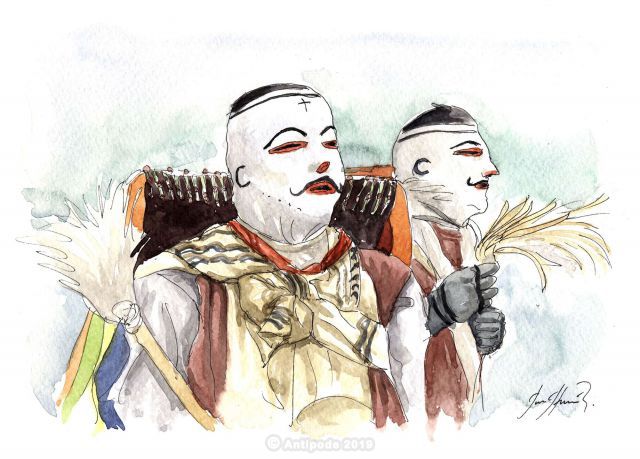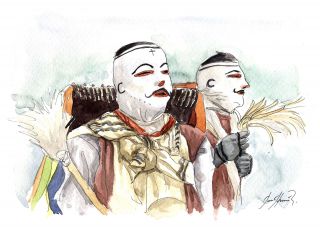

What are the different celebrations and festivities in Peru?
Festivals and celebrations in Peru
January
During the last two weeks of January, Trujillo becomes alive with marineras’ competitions in the main square and in different geographical areas of this town.February
This is Carnival’s month in all Peru: the main ceremony consist in planting a tree and dance around; then they cut down the tree and every one rush to the gifts suspended on branches. Meanwhile, bomb water are flying over and every one sprays mousse on others. A very special festive atmosphere.From the 2nd, and during the next two weeks, Puno celebrate the Candelaria (Candlemas): dances and folk music like Diablada, monstrous masks representing spirits and monsters, this is a celebration for fertility cycle and crops and it ends with a cult of deaths.
March
To the south of Lima, in San Vincente de Cañete, this is the Festival of outdoor sports: you can practice mountain bike, rafting, paraglider, trekking in dunes…At the end of March/beginning of April, all Peru celebrates Holy Week (semana santa): marks of religious fervor overtake people live and the streets fill with parades, music and dance. This celebration is particularly interesting in Ayacucho, where a carpet of flowers is put on the floor so people comes to trample on.
April
In the vicinity of Cusco, they celebrate Señor de los Temblores (Lord of Tremors) throwing away little red flowers, representing Christ blood.From the 15th to 20th, in Pachacamac, a pre-Hispanic site near surroundings Lima, they celebrate Caballo Peruano de Paso (Peruvian horse, a mixture of Spanish and Arab race), pride of Peruvian people.
May
The first, Arequipa celebrates Virgen de Chapi; an all pilgrimage gathers together to travel 45km of night, an estimated 15 hours walk to wash theirs sins.During the first week, near to Cusco, there is the most important pilgrimage of all Latin America: Q’oyllur Rit’i that means “Snow Star” or “Shining Star” in Quechuan language. They start from Ausangante village and walk halfway to the hill of the same name. Dressed up as bears, wearing traditional costumes, with full presents and incense, around 10 000 pilgrims travel every year to adore the picture of a Christ that would appeared to a shepherd, and also to venerate the Apus, mountain divinities, Pachayaya, the Water Mother, etc. One of the most beautiful example of religious syncretism in Peru.
June
During the first week, Cusco is animated by the Beer Festival.From the first to june 7th, Huaraz organizes the Mountain Climbing Week.
During le second week of June, Ica celebrates the grape harvest with the International Harvest festival.
Corpus Cristi is a common point in several cities but is particularly interesting in Cusco; nowadays, they venerate Saints but originally there clearly were pagan rites and there are dances and saints parades in every street.
June 24th, in Cusco, this is Inti Raymi: ultimate Inca Festival. This is the sun adoration when the winter equinox occurred. Very touristic festival and very interesting for the real reproduction of the pre-Hispanic Inti Raymi: the Inca talks to the nation, parades with his soldiers and nobles, all this between celebrations, music and dance. Departure from Q’oricancha and Arrival at Sacsayhuaman where a (false) sacrifice is made to two llamas before the incantation and magic rites.
The same day, in all other areas of Peru, they celebrate Saint John’s Eve. There are planned bonfires, dances, traditional music and parades. Especially in the Amazonian jungle (Iquitos).
The 29th, particularly in Titicaca Lake region, they celebrate Saints Peter and Paul with dances, traditional costumes, music and parades.
July
During the second week of this month, Paucartambo, in the region of Cusco, celebrates Virgen Del Carmen (mamacha del carmen), patron saint of the mestizo population. This is the other big pilgrimage and parade with Q’oyllur Rit’I, like female and male aspect of a thing, important belief for Incas. Such as May, dances, celebrations, parades, processions, costumes and masks are impressive to say the least and induce pilgrims from all over the country.At the end of July, around the 28th; Independence Day in Peru, this is the period of national celebrations (Fiestas Patrias). This is a special time to be with his family and to assist to cockfighting, corridas and parade of horses.
Finally, the Yawar Fiesta takes places in the deep campaign, at 8 hours from Abancay or Ayacucho, on cratered roads. This event that depicts a condor hooked to the back of a bull dates back to colonization and is a sort of indigenous claim. The condor superiority position (representing the native people of the Andes) often lead to victory on the bull (representing the empire of Spain) and to death, like a revenge on the Spanish empire. This celebration were, among others, told by José Maria Arguedas (see Peruvian Literature), in his masterpiece with the same name as the celebration.
August
Lima celebrates its patron, Santa Rosa de Lima (Saint Rose of Lima), in a celebration full of religious fervor, parades and music.September
Spring Festival in Trujillo during the last week (dances, songs, parades…).Andahuaylas (near to Abancay) celebrates the Virgen de Cocharcas, similar to Virgen de la Candelaria in Copacabanca, Boliva and on the shore of Titicaca Lake (benediction of cars, religious processions, etc.).
October
The most popular Saint in all Latin America, Señor de los Milgros (Lord of miracles) is adored during all October. It’s one of the few saints “Moreno”, black, of the continent. For this period of the year, many people are dressed in purple (favorite color of this saint that is known to answer the prayers during this month and bring miracles. Sundays are often set aside to corridas.During the second week, in Abacaya, Piura, they celebrate Señor Cautivo (Captive Lord), known to be miraculous as well.
During the third week, Ica celebrates Señor de Luren.
November
The first, All Saints’ Day is celebrated in all the country, and the second, for the Day of the Dead, families go to cemetery to visit their family members.From the 5th, this is Puno’s Week, with plenty of festivities, where they talk about the foundation of the Inca Empire.
December
Obviously, the Natividad (The Nativity, Christmas) is celebrated with fervor in all Peru. In the Andes, pictures of religious syncretism between Catholicism and Andean cultural references fill public squares.In Cusco, the 24th (the day before Christmas), Santiranticuy is a little bit our Christmas Market; on the Main Square we can admire or purchase plenty of articles providing from handicraft like pottery, ceramic, dolls, etc.
Finally, on December 27th, on the coast, the Afro-American black communities celebrate their patron Virgen Del Carmen, nicknamed during this period: Peoncita.



